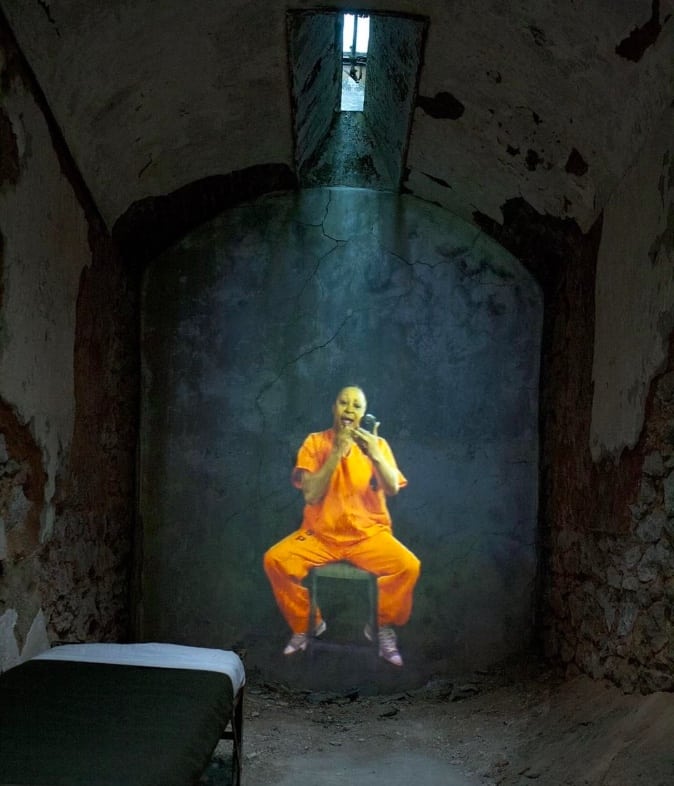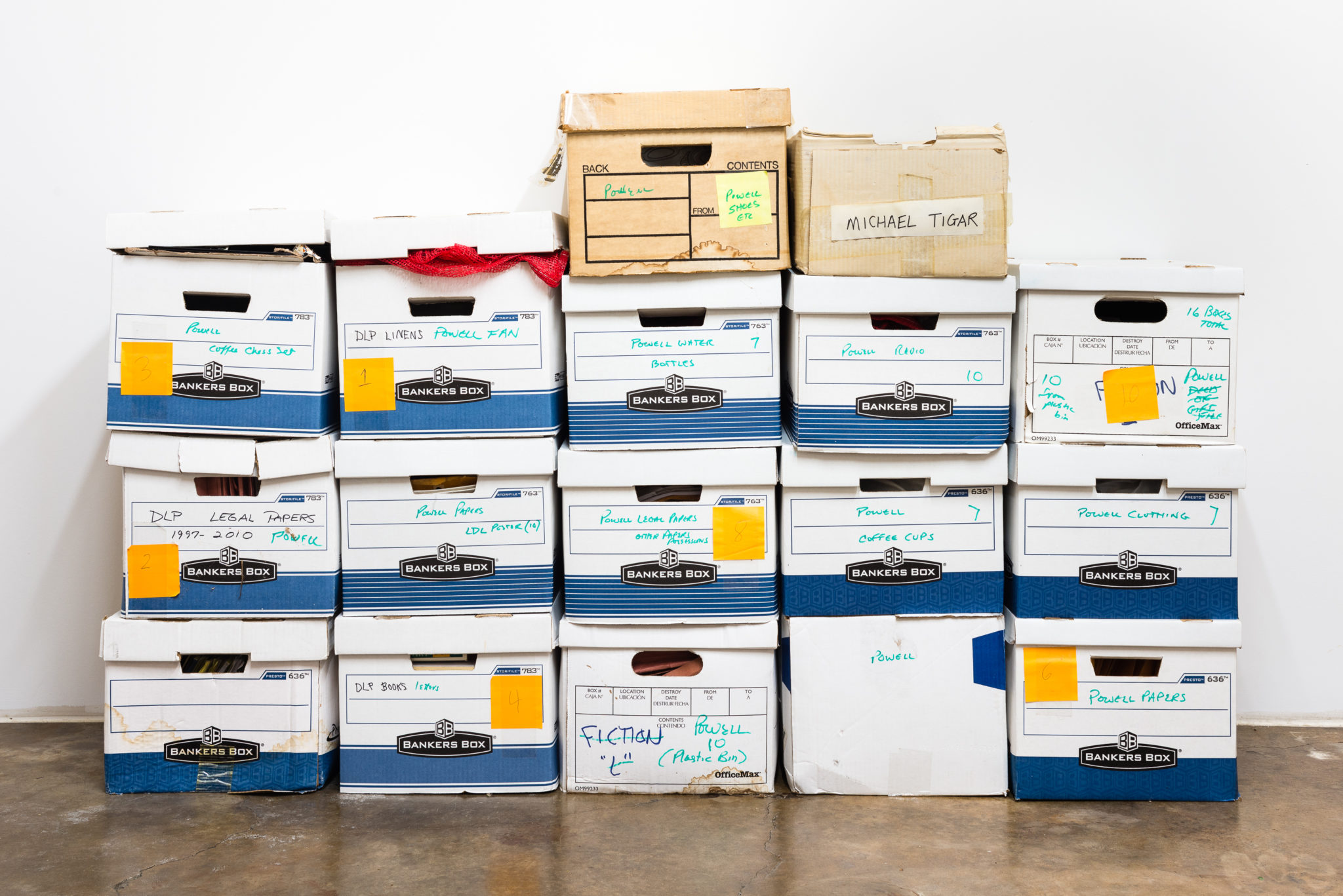
A Houston Art Exhibit Gazes Unflinchingly at the Cruelty of Mass Incarceration
Featuring art from many current and former prisoners, Walls Turned Sideways gives visitors a visceral sense of confinement.

Above: Michelle Handelman, "Beware The Lily Law," 2011. Site-specific video installation, Eastern State Penitentiary, Philadelphia.
Last month, prisoners across the United States launched a coordinated work strike to protest the widespread use of forced labor, which the strikers described as “prison slavery.” An estimated 800,000 American prisoners are put to work each day against their will. In five states, including Texas, prisoners receive no compensation for their coerced labor; elsewhere, they earn a tiny fraction of the local minimum wage. All of this is legal under the 13th Amendment, which outlawed slavery “except as a punishment for crime whereof the party shall have been duly convicted.”
The prison strike happened to coincide with the opening of a powerful new exhibition at the Contemporary Arts Museum Houston (CAMH) titled Walls Turned Sideways: Artists Confront the Justice System. Named after an epigram by Angela Davis — “Walls turned sideways are bridges” — the show includes the work of 42 artists and artist collectives from across the country, many of them current or former prisoners. The multimedia exhibition, on display until January 6, is accompanied by an ambitious, 464-page catalog containing essays by dozens of scholars, artists and activists.
Five years in the making, the exhibition was organized by Risa Puleo, a freelance curator and Northwestern University doctoral student who studies the history of museums in the context of other modern institutions, such as the hospital, zoo, university, library — and prison. Citing the popular “exhibitions” of colonized subjects in European museums and expositions in the early 20th century, Puleo argues that the museum and prison share a common ancestry. “If we can expand our idea of what an object is to include people, then how does the prison carry on that function?” Puleo said. “How is the prison also a collection of people?”

In 2013, a yearslong campaign by a group of Chicago artists, poets and musicians called the Tamms Poetry Committee forced Illinois to shut down the Tamms Supermax prison, which had become notorious for its use of solitary confinement. Inspired by their example, her academic work and the recent incarceration of a member of her family, Puleo began developing the exhibition that became Walls Turned Sideways. Rather than featuring only art about the justice system, she also sought out artists who were intervening in that system.
“I wanted to focus on artists who were using their art strategically to show us something we didn’t know,” Puleo says. “I’m not an activist, I’m not a lawyer. I’m a curator. So what is the thing that only art can do?”
The exhibition, which occupies the main floor of the trapezoidal Contemporary Arts Museum building, is organized according to the stages of entanglement with the criminal justice system, beginning with a section about racial profiling and proceeding counter-clockwise around the museum perimeter through units devoted to arrest, detention, trial, punishment and, ultimately, execution. Evoking the stations of the cross, the exhibition gives visitors a visceral sense of bureaucratic entrapment and increasingly claustrophobic confinement.

One of the first works to greet the visitor is an official-looking wall diagram by English-born artist Jenny Polak depicting a floorplan of the museum with the exits clearly marked. Titled “ICE Escape Sign,” it’s intended to show undocumented visitors how to get out of the museum safely during a potential raid by U.S. Immigration and Customs Enforcement officers. Polak developed the idea for the sign during the last years of the George W. Bush administration, which saw a series of high-profile ICE workplace raids. She has designed versions of the work for several other museums and galleries across the country.
“I found that American citizens often had no idea that people around them were vulnerable to ICE raids,” Polak said. “There was a kind of weird divide, and I always felt it was important for people who don’t have those anxieties to know what’s going on.”
Toward the end of the exhibition is an enlarged photograph by San Antonio artist Mark Menjivar of the boxes containing the last possessions of David Lee Powell, a Texas man who was executed in 2010 after spending 32 years on death row — a state record — for the 1978 murder of a police officer. Above the photograph is an itemized list of Powell’s possessions, from mundane toiletry items to a sizable library of novels and legal books. The simple list of possessions eloquently communicates the reality of three decades lived in a small cell.

“A lot of the time when we talk about capital punishment, people ask, ‘Well, what did he do?’” Menjiver said. “I’m really trying to change the conversation to, ‘What are we doing?’”
For the exhibition’s opening, New York artist Autumn Knight re-staged “Do Not Leave Me,” a work she first performed at Houston’s PEVETO Gallery in 2014. In the original performance, a video of which is included in the exhibition, Knight silently approches various members of the audience, touching their hair, tracing their tattoos or initiating other bodily contact. Then she steps back, pulls out what appears to be a handgun (it’s actually a replica), and points it around the room before lying down on the floor and throwing the gun away as if under police orders.
The performance was originally inspired by Trayvon Martin’s murder in 2012. But the fatal stabbing of an African-American teenager, Nia Wilson, by a white man at an Oakland BART station in July suggested an alternate ending. At the CAMH, instead of pulling out a fake handgun, Knight took a box cutter and made a cut in her palm. Then she reached into her mouth and began taking out the razor blades she had been concealing in her cheeks throughout the performance.

Knight describes the work as a “meditation on the ownership of weapons and their inherent danger.” The original performance “came out of the moment after Trayvon Martin was murdered, when there was a lot of discussion about ‘Stand Your Ground’ and what that meant. And for whom. But I also wanted to think about more recent examples of violence.”
Puleo, the show’s curator, said she was happy to see the nationwide prison strike coincide with the opening of the exhibition — confirmation, along with the current debate over the Trump Administration’s “zero tolerance” immigration policy, of the show’s timeliness. “That’s something I couldn’t have planned in any way,” she said.
She hopes the art on display will help visitors better understand the scope and power of America’s criminal justice system. “Some people may have been directly impacted by the system, while others may not have had much experience. It’s important not to be heavy-handed or aggressive, but to make a space where, no matter what your politics are, you can have a serious discussion.”


